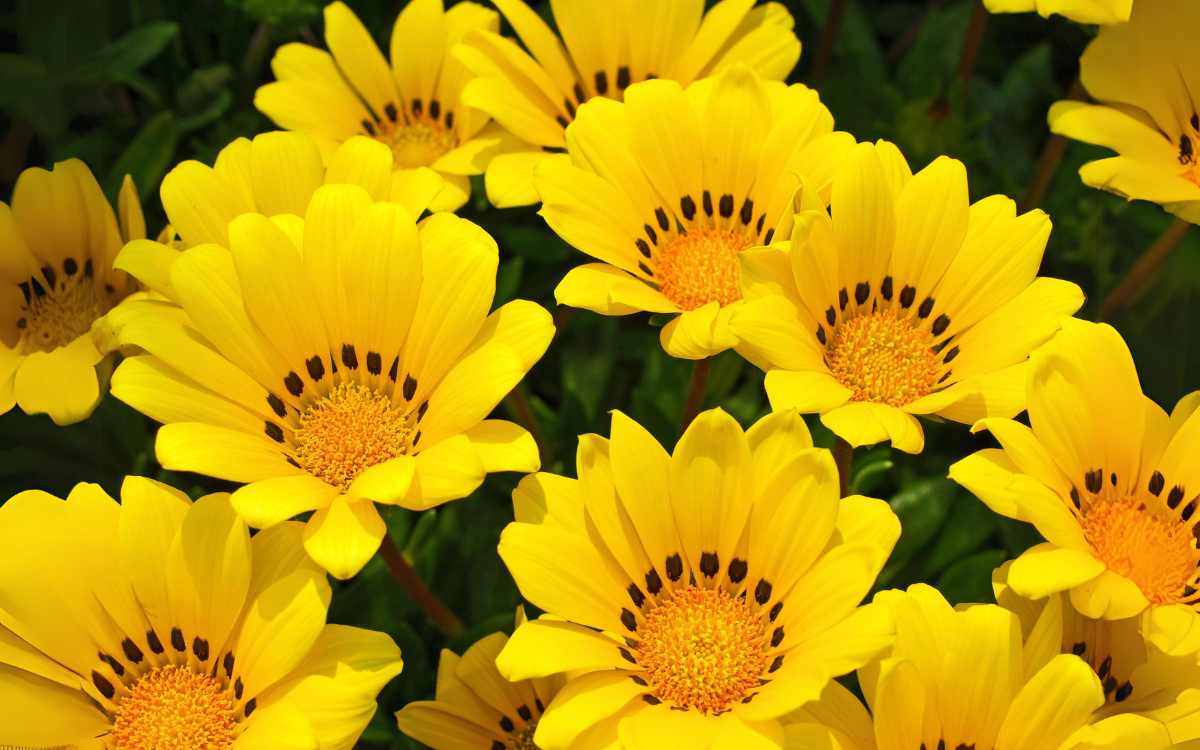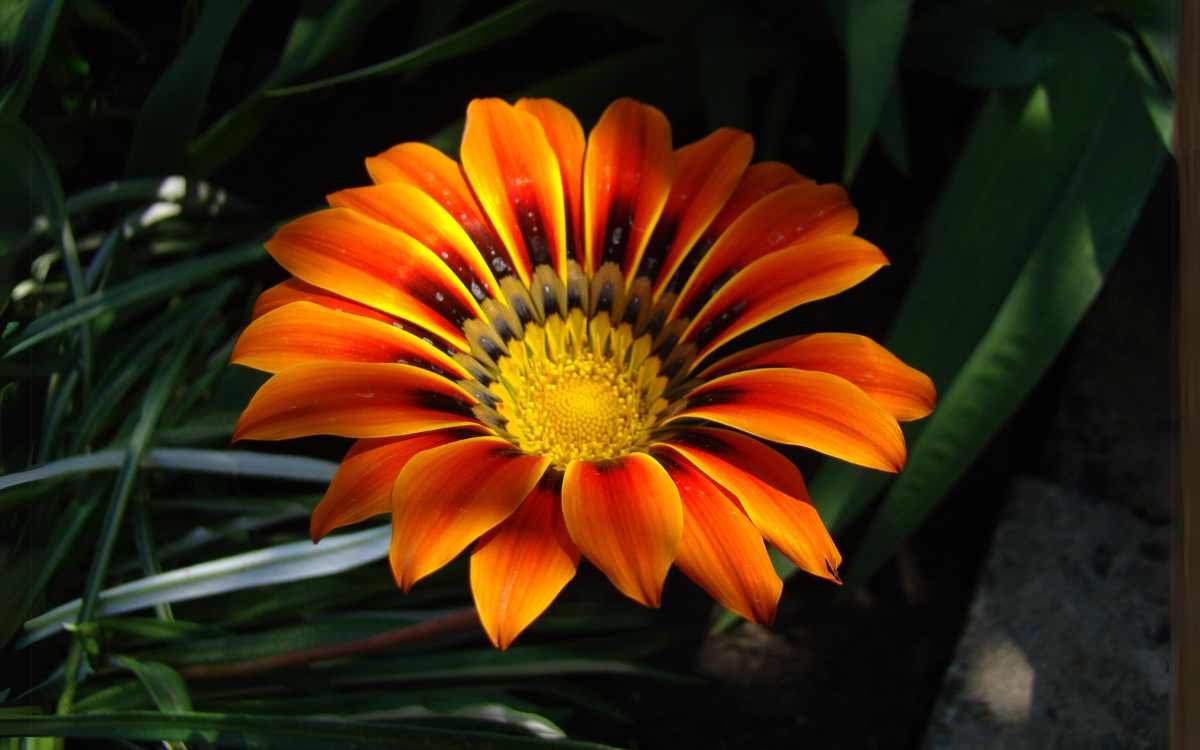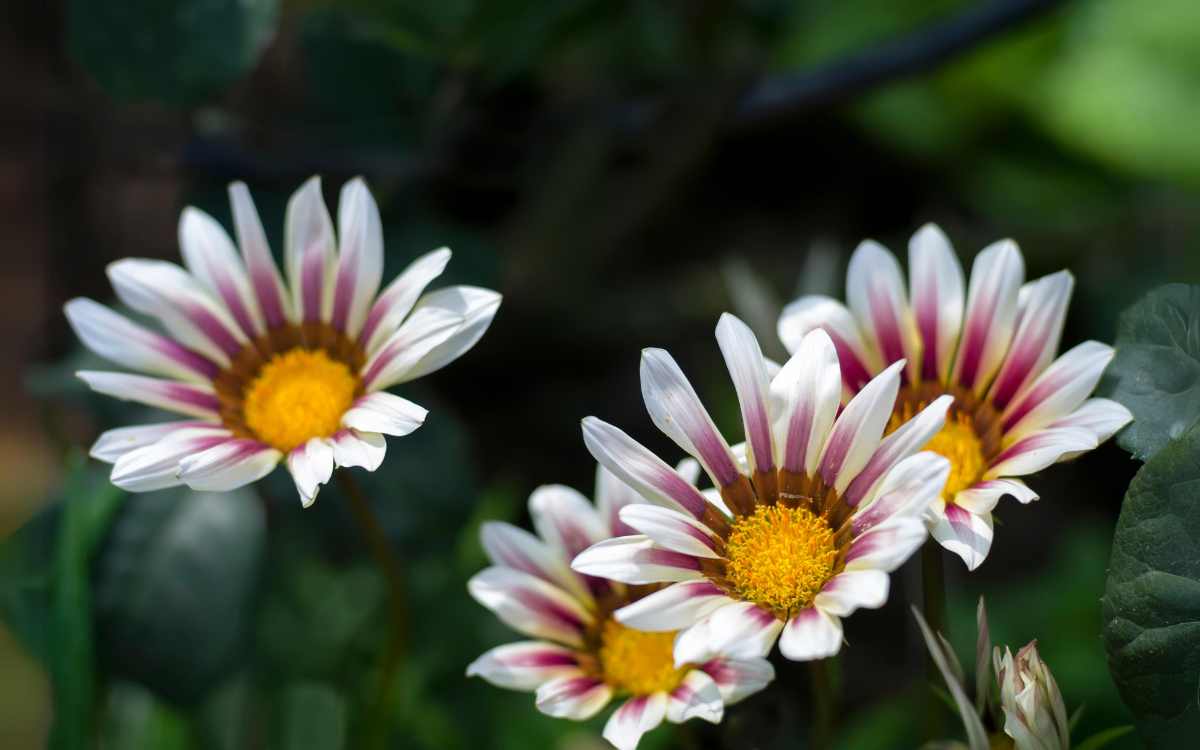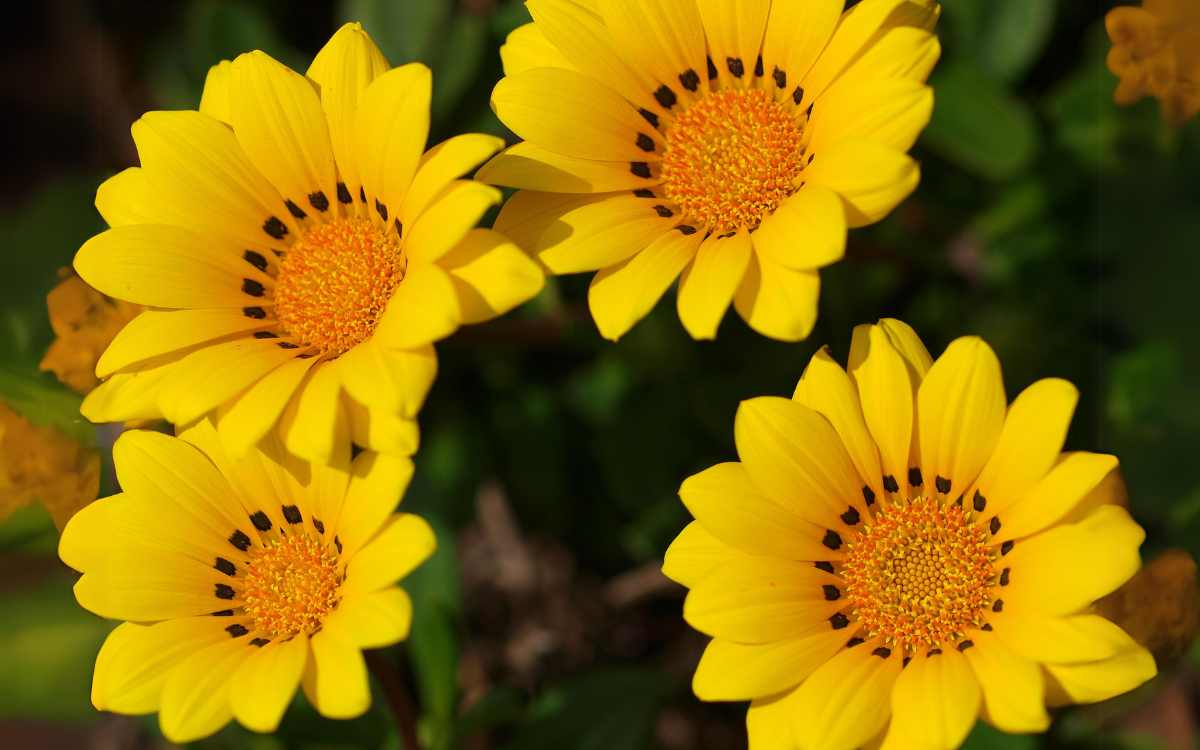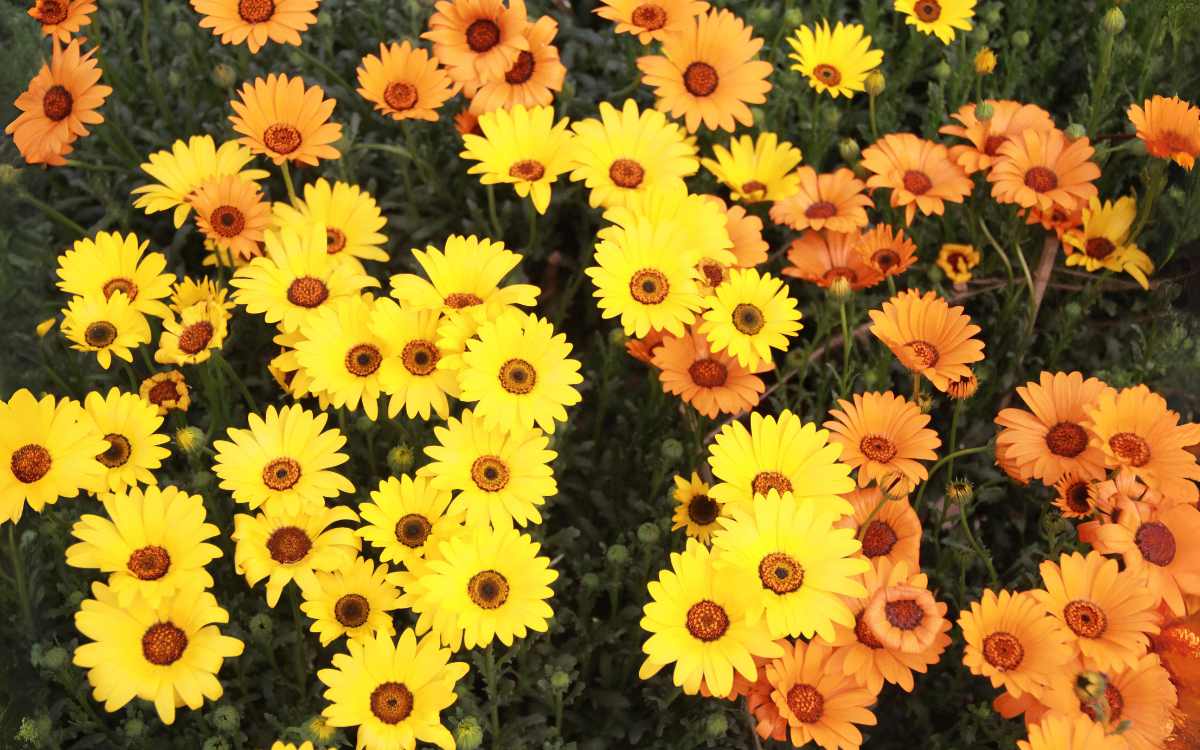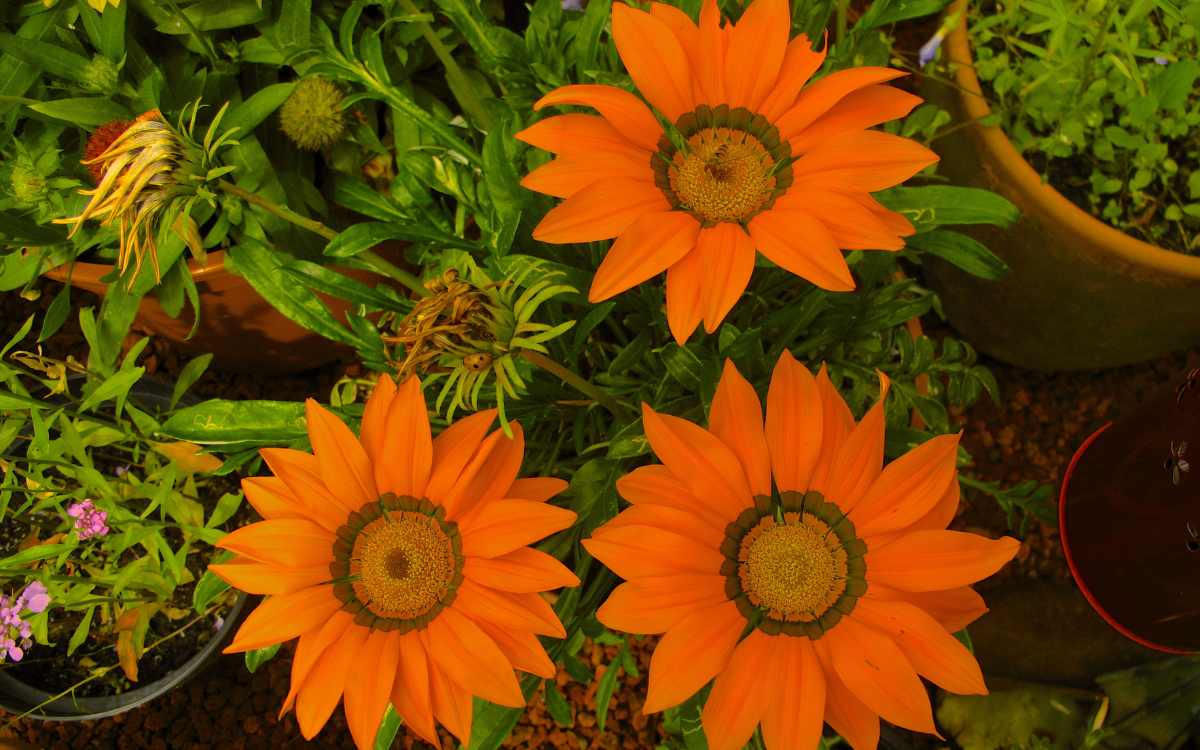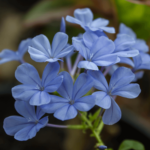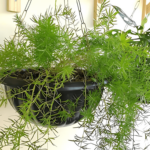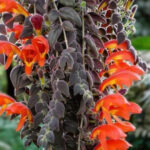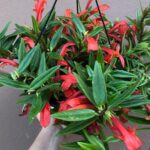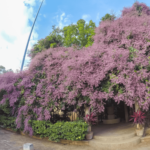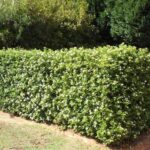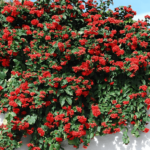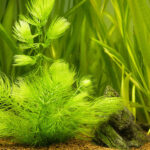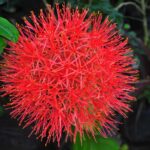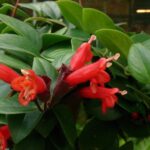Plants of the Gazania genus are native to the coastal areas of southern Africa and are known for their daisy-like flowers. These plants belong to the Asteraceae family.
This genus has a high ability to bloom under adverse climatic conditions, making it a great choice for beginner gardeners.
In this article, I will explore the characteristics and curiosities of Gazania, as well as provide detailed guidance on its cultivation and the necessary care to maintain its beauty and health.
Characteristics of Gazania
Gazania flowers are predominantly orange-yellow, although it is possible to find species in other colors. These flowers tend to close at night or on cloudy days and reopen with direct sunlight.
Botanically, Gazania genus plants are classified as perennials or annuals, depending on the climate and species being cultivated.
They have green leaves that contain white latex and are particularly suited to warm climates, being able to grow well in sandy and well-drained soils.
Gazania also has uses in folk medicine, due to its anti-inflammatory and antioxidant properties, being used to treat conditions such as headaches and rheumatism.
Below, I will explain how to care for these plants, which can be cultivated in a variety of environments, including pots, hanging baskets, or as mass plantings in gardens.
Ideal Climate
Gazania, native to South Africa, is a plant adapted to subtropical and tropical climates, which reflects its origins in an environment that is generally hot and dry.
Gazania thrives in full sun conditions, requiring direct sun exposure for at least six hours daily to ensure healthy growth and vibrant flowering.
This plant is particularly tolerant of dry climates, adapting well to regions where high temperatures are constant.
As it is native to an environment that rarely faces extreme cold, Gazania does not cope well with very low temperatures.
Ideal Soil for Gazania
The ideal soil for cultivating Gazania must be well-drained, as the plant has little tolerance for excessively moist soils, which can lead to root decay.
Soils with a high drainage capacity are essential, especially sandy soils that naturally allow good air and water circulation.
Although Gazania can tolerate nutrient-poor soils, it benefits from a moderately fertile soil, where organic matter can be added to improve soil structure and nutrition.
The ideal pH range for the soil where Gazania will be planted varies from slightly acidic to neutral, typically between 5.8 and 6.2, although the plant also thrives in conditions with a pH up to 7.
The soil should not be excessively rich in humus or manure, particularly those that are fresh and not completely decomposed, as this can lead to excess moisture and potential root rot.
To properly prepare the soil for planting Gazanias, it is recommended to enrich the soil with organic compost or well-decomposed manure before planting. This not only improves drainage and aeration of the soil but also increases its fertility without exceeding in moisture.
This preparation is particularly important in more compact or low-quality soils, where Gazania may not perform as well without this improvement.
See also these articles:
- Blood Lily (Scadoxus Multiflorus): How to Grow and Care
- Congea Tomentosa (Wooly Congea): Characteristics and Care
- Clitoria Ternatea (Butterfly Pea): Characteristics and Care
- Flaming Glorybower: How to Care and Propagate
- How to Grow and Care for Kalanchoe (With Photos)
Adequate Watering
Gazania is a plant that adapts well to long periods without water, especially when grown in its natural environment.
In gardens or pots, the approach should be cautious regarding the amount of water applied. In the initial phase after planting, the soil should be kept moist (not waterlogged) to assist in the establishment of the plant.
After this period, the frequency of watering should be reduced.
The soil should be allowed to dry out completely between waterings.
The general rule is to water the plant only when the soil is dry to the touch.
In dry and hot climates, watering may be necessary up to twice a week, but often, natural rainfall will be sufficient to keep the plant healthy.
Watering in the early morning or late afternoon is ideal, as it allows the water to be absorbed efficiently and the leaves and flowers to dry completely during the day, reducing the risk of fungal diseases.
Focus should be at the base of the plant, avoiding wetting the leaves and flowers directly to prevent health issues.
Fertilization
Gazania, adapted to survive in conditions of low soil fertility, such as the rocky cliffs of South Africa, generally does not require frequent or intense fertilizations.
Fertilization of Gazania should be done in moderation.
The application of a controlled-release fertilizer can be done biannually, which is sufficient to sustain the plant during the growth and flowering seasons.
It is essential to select fertilizers specifically formulated for flowering plants, which typically contain a proper balance of nutrients, focusing on phosphorus and potassium to promote plant health and enhance flower color.
Organic compounds are highly recommended for the fertilization of Gazania.
The use of composting or well-decomposed manure before planting can enrich the soil with essential nutrients without causing harm associated with excessive fertilization.
During the growth season, liquid fertilizers for flowering plants can be applied with care, especially during spring and summer, to give an additional boost to the plant in its most active period.
It is crucial to avoid excessive use of fertilizers, particularly those high in nitrogen, which can inhibit Gazania’s ability to bloom properly.
Excessive fertilization can not only reduce flowering but can also increase the plant’s susceptibility to diseases and the buildup of salts in the soil, which is harmful to the overall health of the plant.
How to Propagate
The propagation of Gazania can be done by two main methods: cuttings and seeds.
Propagation by Cuttings
Propagation by cuttings is an effective way to multiply Gazania, ensuring that new plants retain the characteristics of the mother plant. To start the process:
- Selection of Cuttings: In spring, choose healthy and vigorous branches from the mother plant. Use a sharp and clean pruning shear to cut segments about 2 to 4 inches (5 to 10 centimeters) long. Preferably, choose branches that have not yet flowered.
- Preparation of Cuttings: Remove the leaves from the bottom of the cuttings to prevent decomposition and dip the base in rooting hormone to stimulate root development.
- Planting: Plant the cuttings in a pot with well-drained and moist soil, such as a mix of sand and peat or a commercial rooting substrate. Bury about 1 to 1.6 inches (3 to 4 centimeters) of the cutting base in the substrate.
- Post-Planting Care: Keep the substrate constantly moist, but not waterlogged, and place the pot in a bright location, yet protected from direct sunlight. Cover the pot with a plastic bag to maintain high humidity, which is crucial for successful rooting.
- Monitoring: After about 3 weeks, check the progress by gently pulling on the cutting. Resistance indicates that rooting has been successful.
Propagation by Seeds
Propagation by seeds offers a way to generate a large number of plants:
- Sowing: Plant Gazania seeds in well-drained and moist soil during spring or summer. A sunny location is ideal for germination.
- Germination: Seeds usually germinate within about a week. Cover the container with plastic to maintain a moist environment.
- Care of Seedlings: Water regularly to keep the soil lightly moist, but be careful not to overwater, as this can promote root rot. Seedlings are ready for transplanting when they are about 5 to 6 weeks old and robust.
Common Pests
Aphids and Scale Insects: These sap-sucking insects can cause discoloration and deformation of the leaves, as well as leave a sticky residue known as honeydew, which can attract ants and favor the development of sooty mold.
For control, manual removal or the application of a water jet can be effective for light infestations. In more severe cases, natural insecticides such as neem oil can be used.
Mites: These small arthropods can cause discoloration and damage to the leaves. A strong rinse with water or the use of specific acaricides can help control their population.
Damage Caused by Animals: Snails, slugs, and even birds can cause physical damage to the leaves and flowers of Gazania. Measures such as physical barriers or repellent products may be necessary to protect the plants.
Common Diseases
Powdery Mildew and Leaf Spots: These fungal diseases are characterized by spots on the leaves, which can be yellowish, grayish, or other colors.
Prevention includes ensuring good air circulation around the plants and avoiding wetting the leaves during watering. Ecological fungicides can be applied if cultural practices are not sufficient.
Root Rot: This disease occurs frequently in soils that do not drain well or when the plant is overwatered.
Prevention is the best strategy, ensuring that the soil is well-drained and avoiding waterlogging. In advanced cases, it may be necessary to remove and discard affected plants to prevent the spread of the disease.

